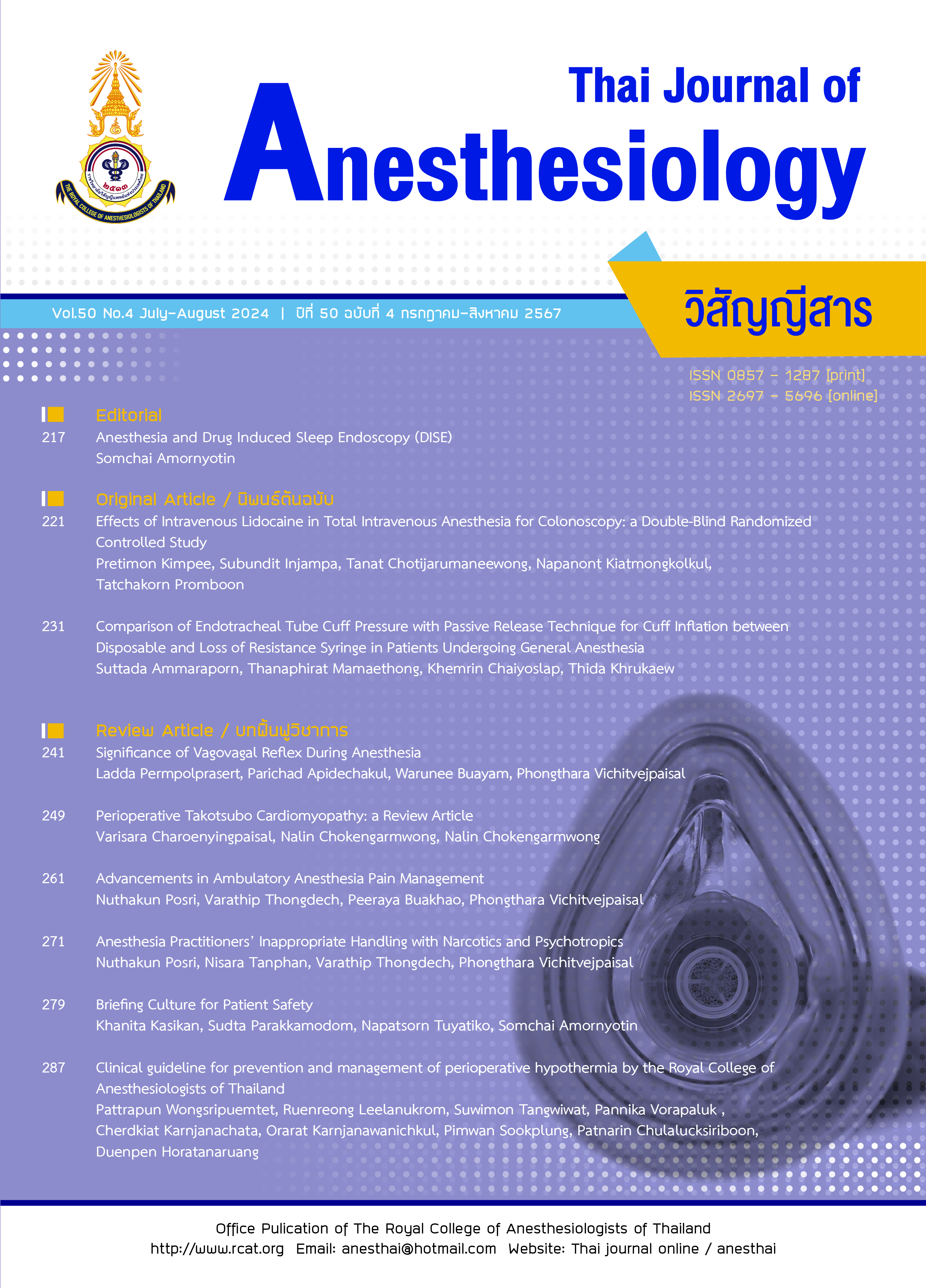Advancements in Ambulatory Anesthesia Pain Management
Main Article Content
บทคัดย่อ
This article discusses the advancements in ambulatory anesthesia pain management and their implications for modern healthcare. The importance of effective pain management in ambulatory settings is emphasized, along with the challenges of traditional pain management techniques. The article then focuses on multimodal analgesia in ambulatory anesthesia, explaining its rationale and detailing the various drugs and techniques used. Furthermore, the article discusses the role of technology in ambulatory anesthesia pain management. It focuses on advancements in pain assessment tools, drug delivery systems, and the use of virtual reality as a distraction technique. The integration of patient-centered approaches in pain management is also explored emphasizing individualized pain management plans and patient engagement. The article also addresses the management of chronic pain in ambulatory anesthesia patients, emphasizing the need to identify and develop specialized pain management strategies for this population. It also discusses strategies for addressing safety and complications in ambulatory anesthesia pain management. The future directions of ambulatory anesthesia pain management are explored, with a focus on potential areas for further research and advancements in the field.
Article Details

อนุญาตภายใต้เงื่อนไข Creative Commons Attribution-NonCommercial-NoDerivatives 4.0 International License.
เอกสารอ้างอิง
Lee JH. Anesthesia for ambulatory surgery. Korean J Anesthesiol. 2017;70:398-406.
Sohn HM, Ryu JH. Monitored anesthesia care in and outside the operating room. Korean J Anesthesiol. 2016;69:319-26.
Pregler JL, Kapur PA. The development of ambulatory anesthesia and future challenges. Anesthesiol Clin North Am. 2003;21:207-28.
Zwolinski NM, Patel KS, Vadivelu N, Kodumudi G, Kaye AD. ERAS protocol options for perioperative pain management of substance use disorder in the ambulatory surgical setting. Curr Pain Headache Rep. 2023;27:65-79.
Cukierman DS, Cata JP, Gan TJ. Enhanced recovery protocols for ambulatory surgery.
Best Pract Res Clin Anaesthesiol. 2023;37:285-303.
Williams AC, Craig KD. Updating the definition of pain. Pain. 2016;157:2420-3.
Kehlet H. Procedure-specific postoperative pain management. Anesthesiol Clin North Am. 2005;23:203-10.
O’Neill A, Lirk P. Multimodal analgesia. Anesthesiol Clin. 2022;40:455-68.
Amaechi O, Huffman MM, Featherstone K. Pharmacologic therapy for acute pain. Am Fam Physician. 2021;104:63-72.
Husband M, Mehta V. Cyclo-oxygenase-2 inhibitors. Cont Educ Anaesth Crit Care Pain. 2013;13:131-5.
Schug SA, Chandrasena C. Postoperative pain management following ambulatory anesthesia: challenges and solutions. Ambul Anesth. 2015;2:11-20.
Riccardi A, Guarino M, Serra S, et al. Narrative review: low-dose ketamine for pain management. J Clin Med. 2023;12:3256.
Giovannitti JA Jr, Thoms SM, Crawford JJ. Alpha-2 adrenergic receptor agonists: a review of current clinical applications. Anesth Prog. 2015;62:31-8.
Han C, Kuang MJ, Ma JX, Ma XL. The efficacy of preoperative gabapentin in spinal surgery: a meta-analysis of randomized controlled trials. Pain Physician. 2017;20:649-61.
Park CM, Inouye SK, Marcantonio ER, et al. Perioperative gabapentin use and in-hospital adverse clinical events among older adults after major surgery. JAMA Intern Med. 2022;182:1117-27.
Shams D, Sachse K, Statzer N, Gupta RK. Regional anesthesia complications and contraindications. Clin Sports Med. 2022;41:329-43.
Kamel I, Ahmed MF, Sethi A. Regional anesthesia for orthopedic procedures: what orthopedic surgeons need to know. World J Orthop. 2022;13:11-35.
Fuller AM, Bharde S, Sikandar S. The mechanisms and management of persistent postsurgical pain. Front Pain Res (Lausanne). 2023;4:1154597.
Werner MU, Kongsgaard UE. Defining persistent post-surgical pain: is an update required. Br J Anaesth. 2014;113:1-4.
Treede RD, Rief W, Barke A, et al. Chronic pain as a symptom or a disease: the IASP classification of chronic pain for the international classification of diseases (ICD-11). Pain. 2019;160:19-27.
Ghai B, Jafra A, Bhatia N, Chanana N, Bansal D, Mehta V. Opioid sparing strategies for perioperative pain management other than regional anaesthesia: a narrative review. J Anaesthesiol Clin Pharmacol. 2022;38:3-10.
Haverfield MC, Giannitrapani K, Timko C, Lorenz K. Patient-centered pain management communication from the patient perspective. J Gen Intern Med. 2018;33:1374-80.
Thiel B, Godfried MB, van Huizen EC, et al. Patient reported postoperative pain with a smartphone application: a proof of concept. PLoS One. 2020;15:e0232082.
Wang XS, Gottumukkala V. Patient-reported outcomes: is this the missing link in patient-centered perioperative care? Best Pract Res Clin Anaesthesiol. 2021;35:565-73.
Malik O, Kaye AD, Kaye A, Belani K, Urman RD. Emerging roles of liposomal bupivacaine in anesthesia practice. J Anaesthesiol Clin Pharmacol. 2017;33:151-6.
Chuan A, Zhou JJ, Hou RM, Stevens CJ, Bogdanovych A. Virtual reality for acute and chronic pain management in adult patients: a narrative review. Anaesthesia. 2021;76:695-704.
Phadke A, Amin P. A recent update on drug delivery systems for pain management. J Pain Palliat Care Pharmacother. 2021;35:175-214.


